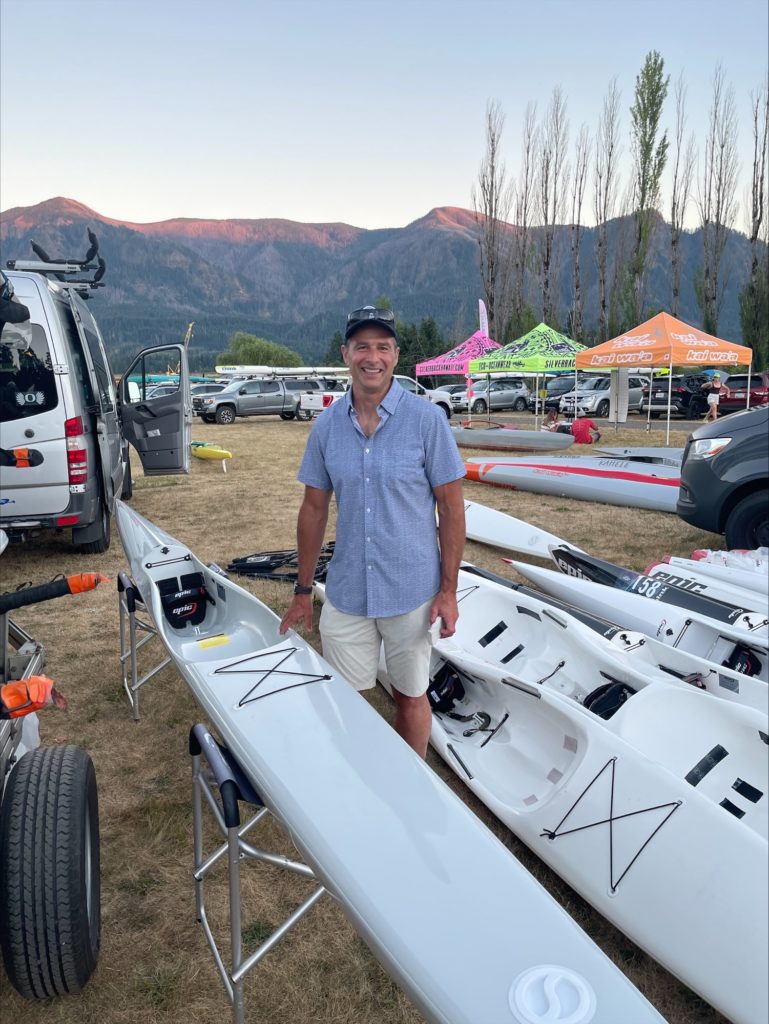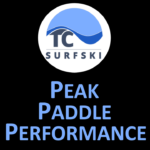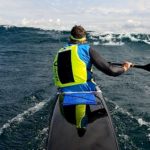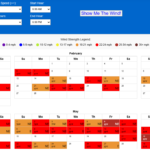Its hard to find many written reviews on the newest Epic Gen 3 V12 and I know there is quite a bit of interest, so after a long hiatus from publishing blog posts, here goes my attempt to articulate my findings thus far.
A Little Background
First the obvious, I’ve been an Epic dealer for 10 years and have paddled almost exclusively Epic boats for the past 15 years. I don’t have any commitment to be exclusive with Epic, but have found that it keeps my business simpler, I trust the quality of their boats, and I’ve had nothing but positive experiences with everyone in the Epic Family. We are all human and therefore have our biases both conscious and unconscious, so I won’t pretend to be unbiased, but will write as honestly as possible. I don’t stock any Epic surfski above a V9, so I have no direct motivation to market elite boats.
For most serious downwind paddlers, it is no secret that Kai Bartlett tapped some magic when he launched the Vega and Vega Flex surfskis. Within a short period of time they exploded in popularity with intermediate to advanced paddlers, and it wasn’t a matter of chasing the shiny new object. The light weight, surfing capabilities, and strength of the build all spoke for themselves. The Vega quickly established itself as the new benchmark for what a well designed downwind ski should be.
I had a chance to try the Vega Flex Pro (18 lbs) on a 10 mile downwind in the spring of 2021 and was impressed by the surfing, maneuverability, and featherweight feeling. It was different than anything I had experienced, but this was also before I paddled the V9. A few months later I received my V9 Elite, and while still 5 lbs heavier, I did find the V9 to be every bit as maneuverable and surfable.
I owned a V12 2nd Gen for a couple years and really loved it, but in the early days of COVID I had a chance to sell it and so reluctantly parted with it. Over the past couple of years I’ve paddled a V10 2nd Gen in the summer and a V8 Pro and V9 in the winter months. I’ve always felt the V10 2nd Gen was an underrated boat, especially for flat water speed. But going from any of the newer generation more aggressive rocker boats to the earlier generation was always a serious adjustment. There are certain conditions when the waves are clean and the speed, glide, and bow volume of the 2nd Gen V10 work great, but as soon as things get messy the boats with less rocker profile simply can’t match the latest surfing machines.
Considering a Vega
I was hoping to secure a 3rd Gen V12 for the Gorge this year, but they were still in very limited supply, so I gladly settled for the 2nd Gen V12. At the last minute, Zach Handler mentioned he was considering selling his Vega and would have it out in Hood River if I was interested. I was really excited to feel the magic for myself, and decided that if I loved the boat, I would buy it and race it. We knew it would be a snug fit (I’m 6’3″ 205 lbs, with a 34″ waist), but I was game to see if I could live with the fit. I took it for a Viento run really hoping I would love it. Even with a seat pad and thin Vaikobi shorts, the seat was too snug. I wasn’t impressed with the low seated position and the foot brace/pedal system. At the time, the self centering rudder was also in place and I didn’t feel I had enough rudder travel. I later learned that many of the paddlers are removing that function to allow for more range. The boat did surf very well, and a single Viento run is not enough time to get a good feel for the overall handling of a ski, but in the end, it just wasn’t going to work.
On Wednesday night at the beer tent, Kenny Howell mentioned that Epic just received a delivery of V12 Elites for the Epic Athletes to use, and that had freed up a 3rd Gen V12 Ultra for me to race. I jumped at the chance to take one of the Ultras for a downwind on Thursday and if all checked out, I would race it on Friday. It was a short run from the Fairgrounds to Home Valley, in small conditions, and I was using the rough water weedless rudder. I immediately felt that the 3rd Gen was more nimble and better suited to Gorge conditions than the 2nd Gen. So against all conventional wisdom, I decided mix things up for race day, and race in a boat I’d only paddled one time.
The race went well, especially when there were bumps to chase. I always felt confident that I could close on any boats within my field of view when we were in the bumps. The grind during the doldrums was expected, so I persevered, but the grind for the last 3-4 miles was rough. All in all, the experience of paddling the Gen 3 V12 confirmed that I should seize the opportunity to take one home. That night I picked up a V12 Elite from Kenny.
The next day, the Gorge wind machine was back with a vengeance, and I had a chance to take my new Elite for a Viento run. Catching the bumps toward Mitchell Point I seemed to be burying the bow a lot. As we crossed over for Swell City the V12 came alive and I was in pure flow carving down the waves and turning and leaning the boat on edge more than was necessary, simply because it was so fun. On this day, the runs just kept cranking well past swell city to the take out.
I did a second Viento run driving an NK Double. The wind and waves had built even more along the Oregon side and it was an absolute blast to paddle through, despite the entire bow being under water most of the section from Viento to Mitchell Point
Reflecting back on the conditions that Saturday, I suspect the current was running harder than usual and combined with the strong wind, the waves were super steep and stacked. I’m now convinced that any ski would have been burying the bow in those conditions.
Thanks to Jeff Schnelle at Paddle Dynamics I was able to get the V12 promptly back to Michigan, where I’ve been able to spend more time testing it out including out and backs, two 12 mile downwinds, and a couple of flat water paddles at tempo and L2 pace.
Fit and Comfort
When it comes to fit and comfort, I’m fortunate. I haven’t found an Epic ski that doesn’t fit me well. I don’t make any padding adjustments aside from a basic seat pad to raise my seated position and improve comfort on long flat paddles. Occasionally I will get some chafing just above the tail bone on my lower back when doing longer flat water paddles, but I attribute most of this to my posture and technique and not the bucket design.
The Gen 3 V12 uses the bucket design from the V11, which has been a huge success. It feels just a fraction smaller than the bucket from the Gen 3. With a 34″ waist, I seem to fit well in the bucket, but haven’t tried it yet with thick neoprene, where I suspect it will be a bit more snug. At 6’3″ with a 34″ inseam, I have plenty of leg length with an additional 4 notches left to go. (Note: my preference for leg length has gotten shorter over the years and especially for downwind. I suspect the more constant and immediate leg drive helps with locking into and controlling the boat.) I was really pleased with the seated position that gives the feeling of being up and over the feet. In the last year I have become very sensitive to not wanting to feel “low and back” in the seat, and I definitely don’t feel this way in the V12. Similar to the Gen 2, the V12 has a deep bucket and footwell which makes for a drier ride, at the expense of a tougher remount. The elite skis are designed for speed and the assumption is that anyone paddling them rarely swims, and if they do, they have a bullet proof remount. Hence, these boats are not optimized for ease of reentry.
Stability
Stability in a surfski is always a nuanced discussion and quite often specific to the paddler’s fit and paddling style, and most importantly the conditions and their reference point (primary boat they’ve been paddling). The best example of this, is to paddle a tandem ski and then immediately jump into a single. Any single ski will feel squirrely in the back and that is what you will notice the most. So I would argue, when you first demo a new boat, your first impressions will be heavily weighted toward how that boat is different than the boat you are coming from. With more time in the new boat, your perspective may change entirely. Conditions also matter a lot, and as we know, they are never the same. Aside from Swell city where you get some multidirectional action, the Gorge is generally pretty clean and uniform waves and doesn’t present a big stability challenge. We also tend to do very little upwind paddling at the Gorge. As a result, based on all my paddling in the Gorge, I found the 3rd Gen V12 to be quite stable for an elite ski.
Back to Lake Michigan and paddling in more varied conditions, I have some additional thoughts on stability. With the increased rocker and more forward position of the rudder, the V12 can definitely feel corky when padding upwind and generally whenever it isn’t on a run or the paddler isn’t making clear who’s in control. This takes some getting used to, and I’ve noticed that it forces me to keep my stroke rate at 35 double strokes per minute or above. This is actually a good thing for me, because 35 is my L2/Endurance zone, and I shouldn’t be getting lazy and falling below that.
I’ve felt the same corky feeling with the V9, albeit with a lot more stability. My sense is that light boats with lots of rocker are all going to feel this way. It’s no secret that the latest generation boats are optimized for downwind surfing, and there is a tradeoff. However, I will add that while the loose and corky feeling can make the boat feel less stable in flat water or upwind, in downwind and cross wind it can make the boat feel more stable as it won’t be grabby or sticky. Aside from my first trial run with the rough water weedless, I’ve done all of my paddling in the V12 with the standard Epic surf rudder. It is possible that in most conditions, the V12 doesn’t need this much rudder, and might even handle better with less rudder. It will be interesting to see how this evolves.
In summary, like most elite skis, the V12 is lively. The paddler has to be confident and take control with a powerful and clean stroke. Once you accept that, the secondary stability is excellent and the V12 will respond to whatever inputs you give it.
Flat Water Speed
While optimized for downwind, the V12 is still a quick boat on the flats. Here my main reference point is the V10 2nd Gen GT which I did all of my training in leading up to the Gorge. I’m finding the flat water speed of the V12 to match the V10, which seems about right since both boats are the same weight, the hull is narrower on the V12, but the water line is shorter.
Downwind Speed
Downwind is where the V12 really shines. I would describe it as a dart with a wandering eye, aka, a dangerous weapon. The boat is quick and nimble, and only committed to the run if you want it to be. It is always game to chase after a better wave. I’ve found these characteristics come through in spades when you’re in mixed and confused conditions. In these conditions you are grabbing short bits of surfable wave then quickly making a move to the next bit of surfable wave, this is where the Gen 3 V12 is in its element. I’m convinced Greg Barton achieved his goal with the refined bow design. Aside from that one day in the Gorge, I’ve almost never buried the bow, and when it does start to submerge, it pops back quickly. As of now, I don’t see any need for a wave deflector. The slightly shorter length of the Gen 3 at 20’4″ combined with the increased rocker, makes it feel and handle like a 19′ boat.
I was doing one of my regular runs last week, in a section that isn’t generally very fast, and on a day when the wind and waves weren’t anything special (12 mph, 2 foot) I was averaging 9.5 mph for 5 or 6 kilometers. My sense is that once you start linking runs with the V12 it maneuvers so easily and glides so well, that you can really keep the speed up.
Summary
When the Gen 3 first came out last summer, the big question was, will it supplant the Vega as the ultimate downwind surfing and racing machine? I’m honestly not sure that question has been answered yet. I’m hoping that there are a few paddlers out there who have spent considerable time in the Vega and are now getting a chance to spend considerable time in the V12 and will be willing to summarize their thoughts and findings.
I know I’m very happy with my V12, and trying out some of the other brands is a good reminder that there are some basic features of the Epic skis we tend to take for granted. A sound, proven, and simple foot brace, pedal/rudder system, and bailer are just one example. It goes without saying that the Epic build quality is solid, consistent, and predictable.
With the long cold water season on Lake Michigan, I spend more time in stable beginner/intermediate boats than I do elite boats. This begs the question, is it even worth bothering with elite skis when 99% of my paddling is solo and ultimately the speed differences are fractional. My last couple of weeks paddling the V12 has reconfirmed for me that the answer is a resounding Yes. The flow science tells us that optimal flow states are achieved in situations that are 4% above our skill level. In an elite boat, in the right conditions, this is exactly what I’ve felt. I’m really looking forward to the next couple of months of good downwind in the V12 and chasing some new personal bests. I suspect it will be hard to transition back to the V9 when the temps start to plummet.




